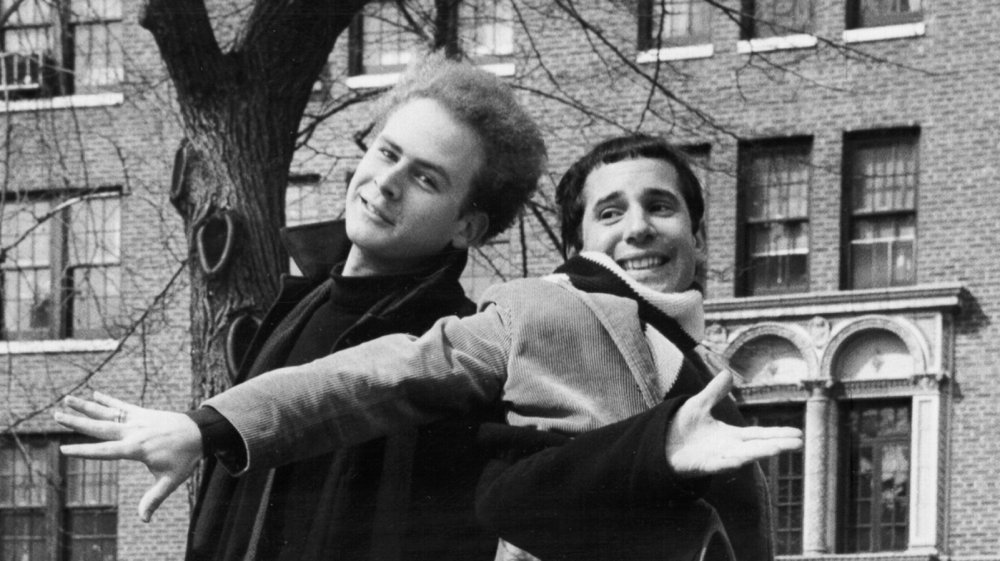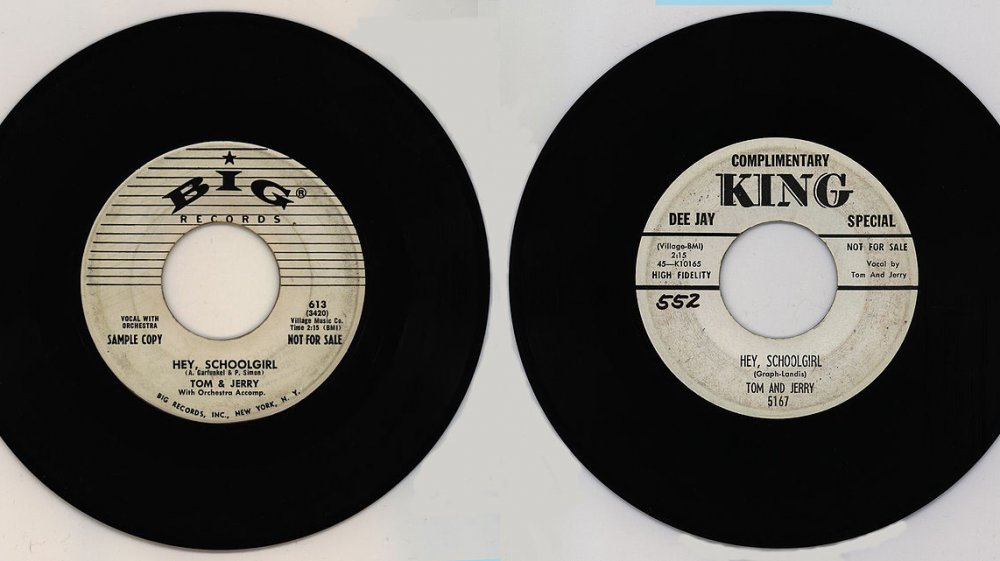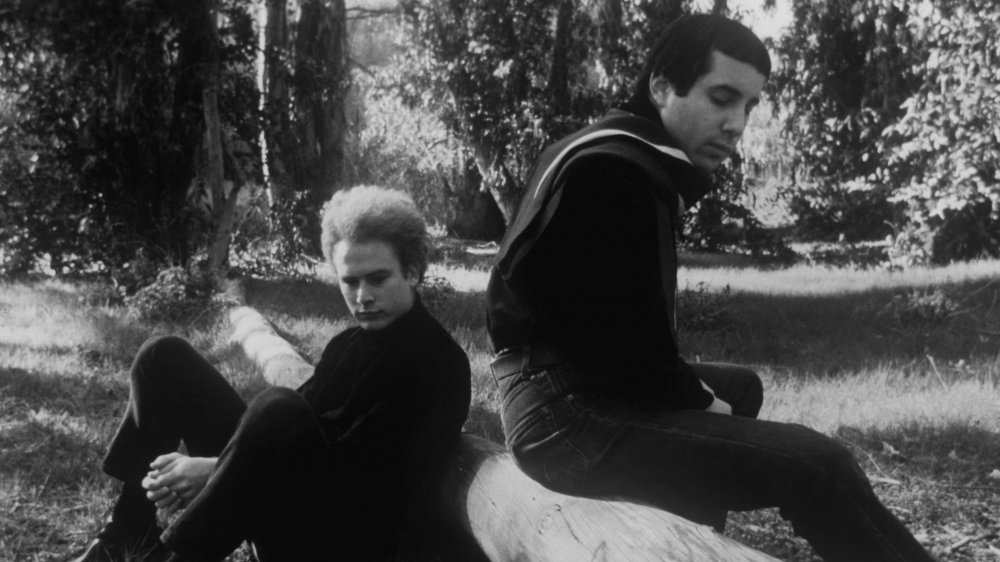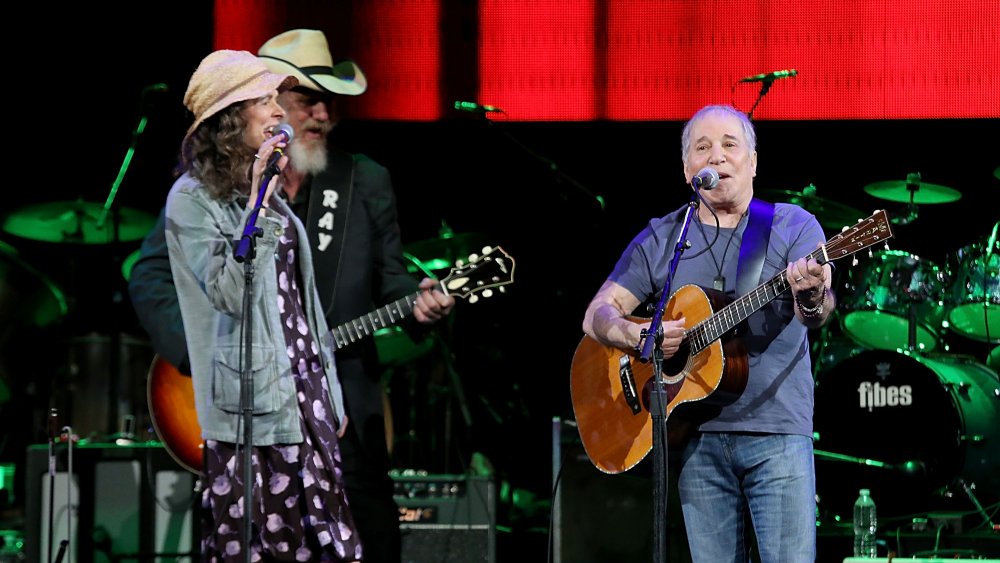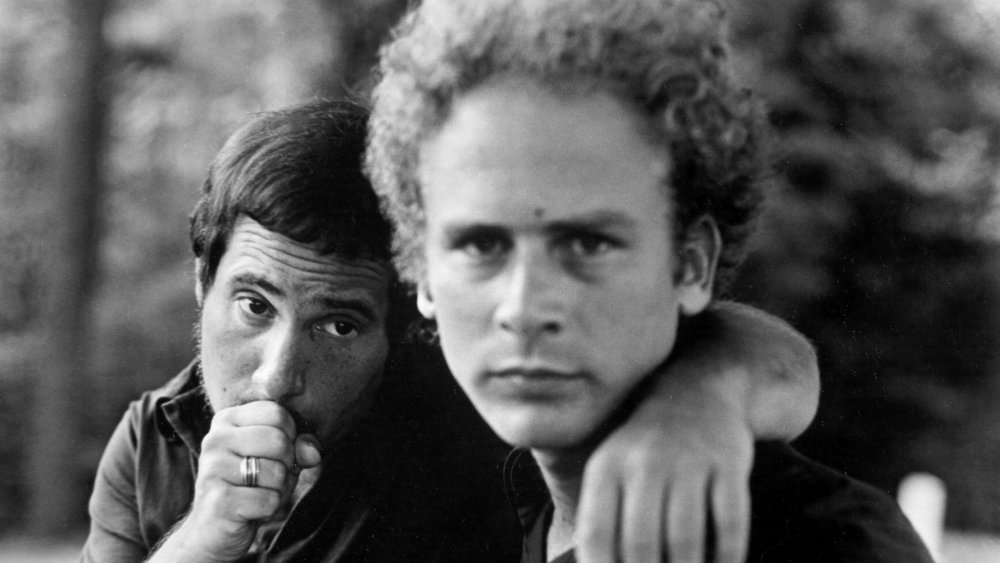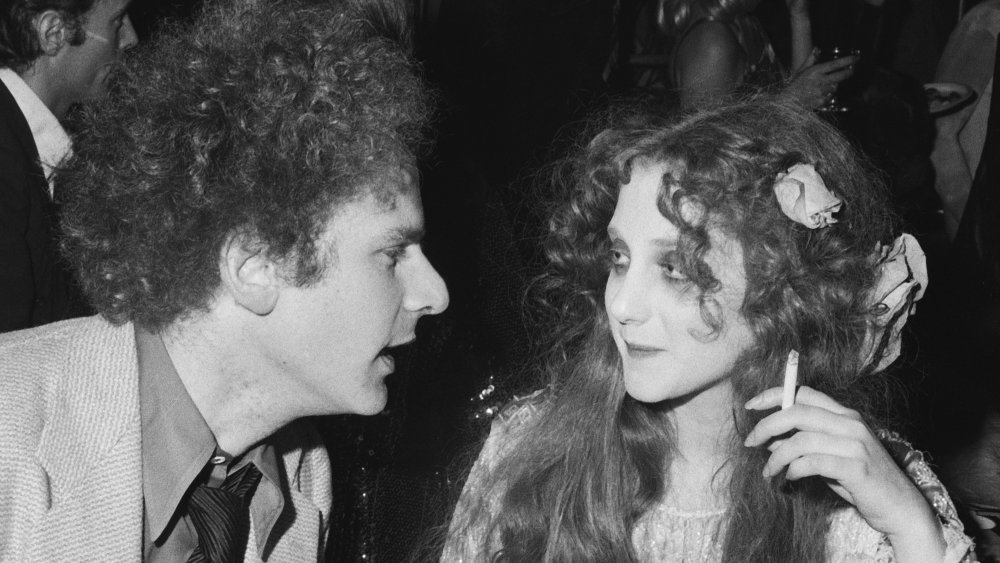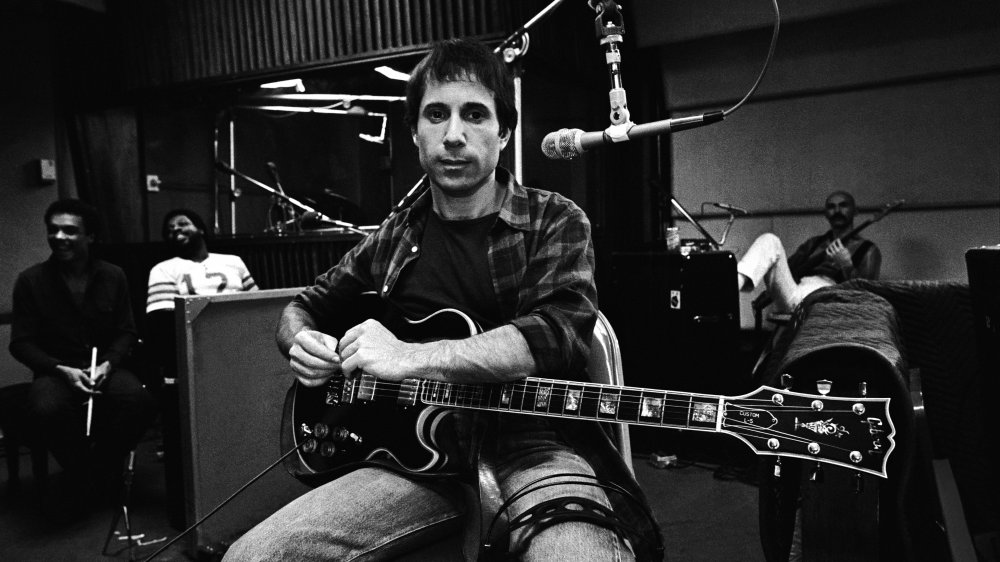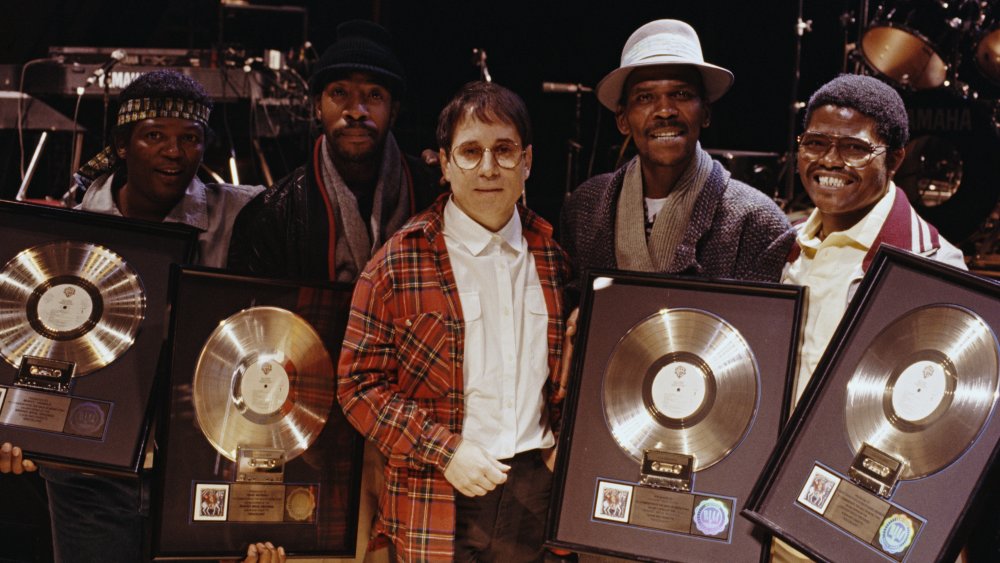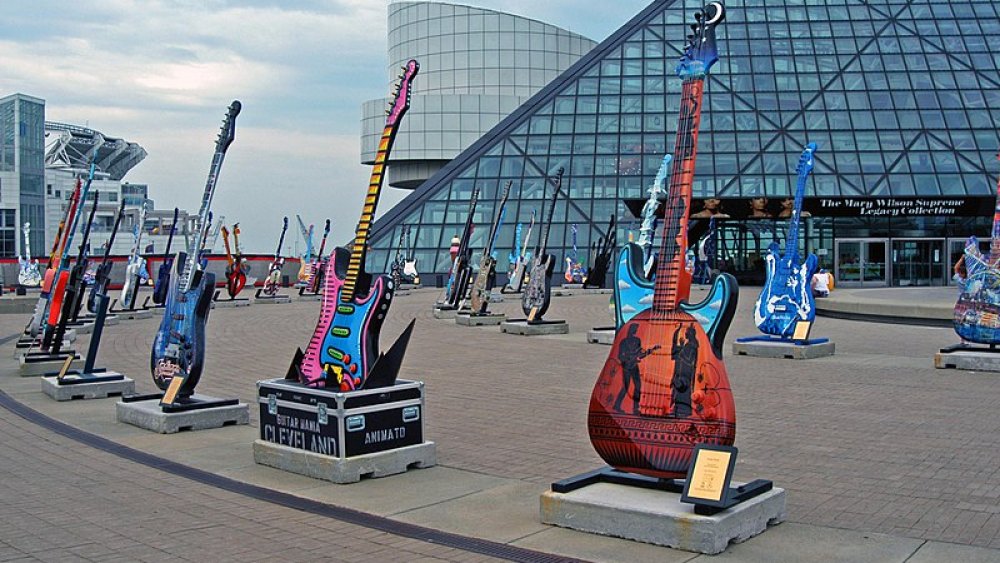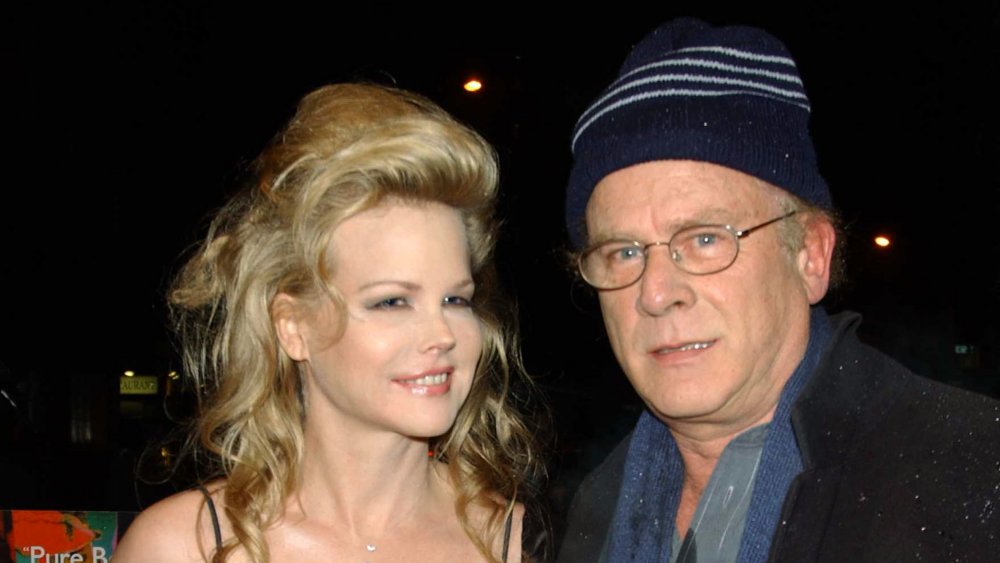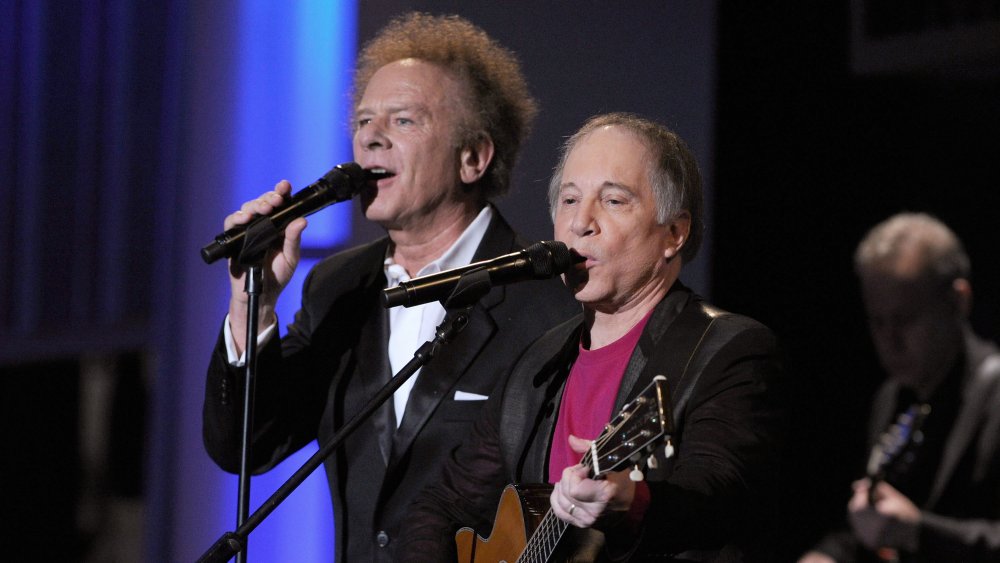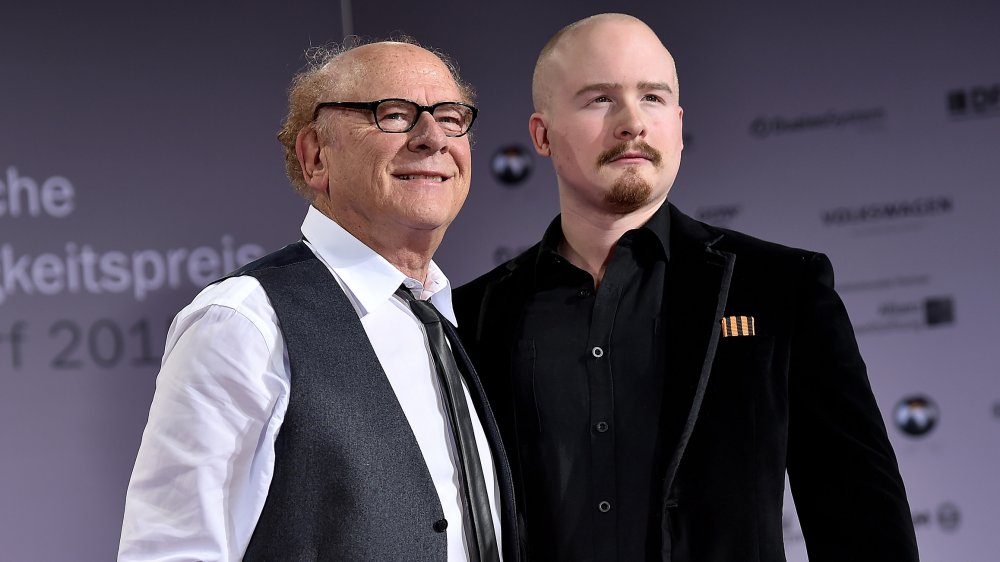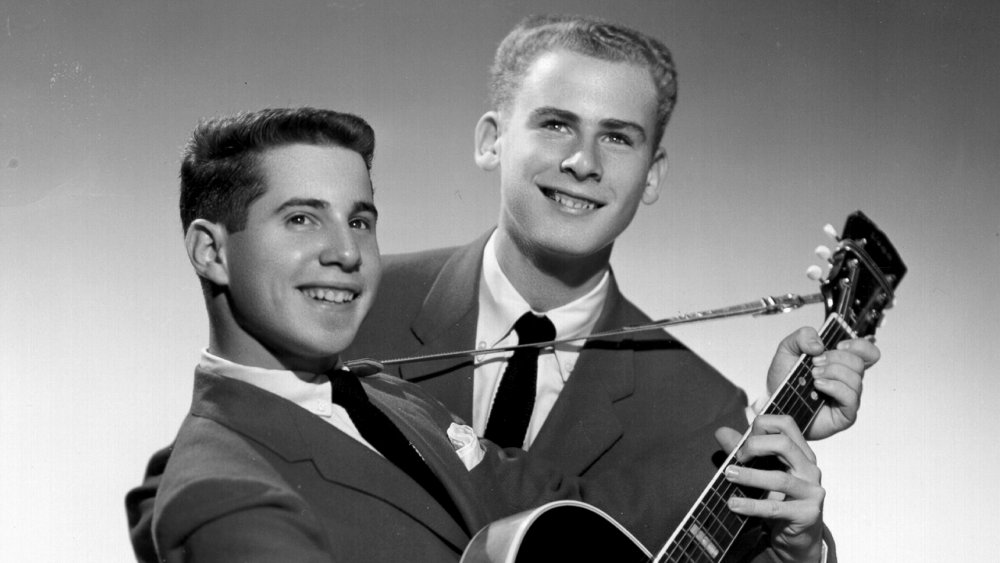The Tragic Real-Life Story Of Simon & Garfunkel
It's been 50 years since the iconic folk duo, Simon & Garfunkel, released their last album together, the name of which would symbolize the duo's relationship: Bridge Over Troubled Water. The band is famous for its numerous breakups and reunions. But if there is such a thing as positive "creative conflict," as Consequence of Sound puts it, Art Garfunkel and Paul Simon have exceeded the boundaries set by other bands in the art of squabbling. Yet even after years of fighting and acrimony, Simon & Garfunkel somehow remain a team even though they are no longer together. "We're very good," Garfunkel explained to Rolling Stone magazine in 2017. "We take two very different people, Artie and Paul, who have very different natures and found a fusion."
In spite of their differences, Simon & Garfunkel remain a favorite of folk fans to this day. Who could forget the lonely solemnity of "The Sounds of Silence," or the feel-good and whimsical "The 59th Street Bridge Song (Feelin' Groovy)," or the heartfelt emotion of "The Boxer?" The musicians truly made a name for themselves as entertainers, with smooth harmonies and memorable hits, before breaking up to pursue their own careers. But it's been a rather rocky road for both men. Here is the tragic real-life story of Simon & Garfunkel.
The making of Simon & Garfunkel
For Paul Simon, the son of an English teacher mother and a bandleader father, music came easy. His father Louis Simon had already appeared on The Jackie Gleason Show and other shows when the family moved from New Jersey to Queens, New York when Simon was around four years old. Smooth Radio says Simon met Art Garfunkel in 1953 when the boys were attending Parsons High School together. Garfunkel, Simon recalled, was "the most famous singer in the neighborhood." Garfunkel's own website says his father brought home a "wire recorder" when he was four years old, igniting his interest in music.
Their mutual love for singing would bring Simon and Garfunkel together not just as best friends, but also singers. The boys spent time listening to music, starred in their school production of Alice In Wonderland, sang together, and started writing their own music. Still, Garfunkel told Mojo magazine in 2020 that he never expected to sing for a living. But after practicing enough to be "professional sounding," the duo signed on with Big Records, called themselves "Tom & Jerry," and recorded their first single, "Hey Schoolgirl" in a Manhattan studio. The song was a Top 50 hit, per the musicians' website. They were just sixteen years old, but both were already perfectionists. Rolling Stone recounts the pair spending weeks in the studio on just one song.
Simon & Garfunkel's first split was a matter of trust
Smooth Radio explains the first issue between Simon and Garfunkel this way: Big Records' head honcho, Sid Prosen, was so excited by the success of Tom & Jerry that he got the duo a spot on American Bandstand, but he also offered Simon a solo deal. Simon accepted. Garfunkel found out and felt "completely betrayed." Was it a sign when Simon's Impala (purchased with his royalties) happened to catch fire in front of Garfunkel's house? Perhaps, because neither Tom & Jerry's subsequent singles or Simon's solo attempts amounted to much. The pair eventually parted ways.
Then in 1963, according to Smithsonian magazine, Paul Simon called Art Garfunkel with the news he'd written some new material. The pair reunited and signed with Columbia Records, All Music reports. Their first album, Wednesday Morning, 3 AM, featured their first big hit, "The Sounds of Silence." Their third album, Parsley, Sage, Rosemary and Thyme, resulted in even more hits. Then, "Mrs. Robinson" from their third album, Bookends, skyrocketed them to fame in 1967 when it was used for the movie The Graduate. Simon & Garfunkel seemed set in rock and roll history. Or were they?
Paul Simon tried to balance his career with marriage
There is no doubt — Simon's three marriages have been tumultuous. In 1969, as Simon & Garfunkel trudged along in their acrimonious fashion, Simon married Peggy Harper. The two had a son in 1972, but Harper began wondering about her husband spending so much time away from home, according to Stuff. Was he being unfaithful? No, said Simon in 2018. His long showers upon returning home were not to wash off the scent of another woman; rather, they were to wash away "the sadness." Unable to fix the marriage, the couple divorced in 1975.
Next, according to the Independent, Simon married Carrie Fisher in 1983. The marriage only lasted a year, but the couple carried on their relationship for another decade. Biography explains that the two met in 1977 and seemingly just couldn't stay away from each other despite their troubles, including Fisher's drug use and mental health problems. Simon eventually proposed — just minutes after saving Fisher from choking on some Brussels sprouts. The couple used a lot of laughter to maintain their relationship but finally split for good when Simon married fellow musician Edie Brickell (pictured with Simon) in 1992. As recently as 2014, however, the couple was in court for disorderly conduct after getting into a physical dispute at their home. The charges, according to Star Advertiser, were dropped.
A catch-22 on the set of Catch-22
By 1970, director Mike Nichols was so enamored by Simon & Garfunkel that he cast the pair in his new film adaptation, Catch-22. That was just fine with Art Garfunkel, whom Biography says was alternating his music career with acting. Just before filming began, however, Nichols inexplicably cut Paul Simon from the cast list. Fellow actor and documentary producer Charles Grodin blamed Nichols for spurring the duo's official breakup. Hollywood Reporter quoted Grodin as saying, "I just think this is outrageous — you don't take Simon & Garfunkel and ask them to be in a movie and then drop one of their roles on them. You just don't do that."
The split was made even more precarious by the success of Simon & Garfunkel's last studio album, Bridge Over Troubled Water, with numerous hits including the title track but also "The Boxer," "Cecilia," and "El Condor Pasa," according to All Music. And if it is possible to experience joy and sadness all at once, Simon & Garfunkel won a Grammy award for the album. In fact, per Billboard, Simon & Garfunkel won two awards for record and album of the year, while Paul Simon was awarded seven Grammys — making him the first musician to win for an album, record, and song all in one night in 1971. Simon's seven-Grammy record stood for a dozen years before Michael Jackson won eight awards in 1984.
Art Garfunkel's early relationships and marriages were equally rocky
With the Grammys behind him, Garfunkel's website confirms the artist retreated to a farm in Scotland with girlfriend Linda Grossman. Paul Simon was present when the couple married in 1972 in Tennessee. But Garfunkel (pictured with actress Carol Kane, 1978) described the union as "turbulent" and "bitter" and admitted he didn't care for Grossman very much. By the time they divorced in 1975, Garfunkel had started a new relationship with actress Laurie Bird. Notably, Bird actually played the girlfriend of Paul Simon's character in 1977's Annie Hall. And unfortunately, her relationship with Garfunkel was not as rosy as it appeared.
Bird spent so much time alone at the Manhattan apartment she shared with Garfunkel that she "came to believe Art was tired of her," according to Open Article. In 1979, after spending four months living alone while Garfunkel was on the road, Bird intentionally overdosed on Valium. Garfunkel was heartbroken, finding temporary solace in a "brief but happy" fling with actress Penny Marshall. Then in 1985 he finally met his current wife, Kim Cermack, a longtime fan who was lucky enough to score a date with the legendary musician. "He is really a beautiful human being," Cermack once told the Savannah Morning News per Art Garfunkel. "I can't tell you how much I love him."
Paul Simon's fame was crippled by depression
In 2011, Rolling Stone called Simon "one of the most important artists of his generation." Between 1970 and the 1990s, the artist produced eight solo albums with songs about his own very personal experiences. Writer Daniel Drake surmised that many of the lyrics to Simon's hits were fraught with sadness and loss. At least the musician managed to turn his depression into art. "Most people look at me and wonder, 'How could that guy be depressed?'" Simon told Playboy's Tony Schwartz in 1984.
In fact, Simon had a lot to say in that Playboy interview about his depression over the years. He first began suffering from it back in 1966, and his tempestuous relationship with Art Garfunkel didn't help. His 1980 film, One-Trick Pony, didn't do well. He went through a bout of writer's block. "I was immobilized," he explained, until he "came under the influence" of psychiatrist Rod Gorney, who helped him search for answers within himself. Later, in 2017, Simon elaborated a bit more, according to Stuff. "You could say that being short is bad news," he said. "Not having a voice that you want. Not looking the way you want." And he never forgot that Garfunkel once taunted him during a photoshoot, telling him, "No matter what happens, I'll always be taller than you."
Simon's trouble with Graceland
If you've ever achieved something absolutely wonderful only to have someone pop your balloon, Paul Simon knows just how you feel. In 1984, he found a new way to battle his depression by creating a special album inspired by South African music. He called it Graceland. Happy tells how Simon flew to South Africa and spent two weeks recording with local musicians to make the album. It was an eclectic combination of "pop, a cappella, isicathamiya, rock, and mbaqanga," says This Day in Music, and it was beautiful. That was in 1986 when Graceland earned Simon his twelfth Grammy award for his effort.
A short time later, a video debuted with comedian Chevy Chase mouthing the words to one of the cuts, "You Can Call Me Al" as Simon wandered around the set, occasionally singing along. The world loved it. But not so fast, cried the UN's Anti-Apartheid Committee, who lambasted the singer for violating an international boycott against South Africa. "The intensity of the criticism really did surprise me," Simon later told Rolling Stone. "Part of the criticism was 'Here's this white guy from New York, and he ripped off these poor innocent guys.'" Simon also firmly maintained he did, after all, go there to play music, not perform, per the Guardian. And, Graceland is still his most popular record to date.
A stroll through the Rock and Roll Hall of Fame
In 1990, The Ringer says, Simon & Garfunkel received one of the most prestigious honors a musician can have: the duo was inducted into the Rock and Roll Hall of Fame. Eleven years later, Paul Simon, who had been an eligible inductee as a solo artist since 1991, was inducted on his own merit. Although the honor no doubt helped his depression, Simon, according to the Rock and Roll Hall of Fame website, "has always been quick to point out that his public career as the songwriting half of Simon and Garfunkel essentially lasted six years." And nothing beyond that.
Indeed, Simon seems to have snubbed his former partner on more than one occasion regarding the inductions. When they received the Hall of Fame honor together, Garfunkel commented that Simon had "enormously enriched my life." Simon declined to return the compliment. But if Garfunkel is complaining (he's been eligible for his own solo induction since 1998, according to Future Rock Legends), he hasn't done so to the public. In fact, Garfunkel actually took the high road in 2014 — by successfully nominating fellow musician Cat Stevens. As for Garfunkel's own right to his induction, fans are still waiting.
Art Garfunkel was arrested for pot
There's a scene in the movie Almost Famous where doting mother Elaine Miller (Frances McDormand) holds up the album Bookends. Pointing at Paul Simon and Art Garfunkel's eyes on the cover, she says to her teenage son William, "Honey, they're on pot." Turns out, it was true, although most of America at the time could hardly fathom that such a dynamic folk duo smoked weed. But they did, and Art Garfunkel was still toking when he was arrested in 2004 for possession. The funny part was that the arresting New York State Trooper, according to the Chicago Tribune, had no idea who the celebrity was when he pulled Garfunkel's limousine over. CNN reported that Garfunkel paid a $100 fine; his driver got a speeding ticket.
A year later, Garfunkel got nailed for possession a second time in New York when he was pulled over and the officer smelled what turned out to be "a marijuana cigarette" in his ashtray, according to People. This time the singer was given a ticket and went to court. After years of consuming both tobacco and cannabis, Garfunkel gave both up for good in 2010. And when San Diego Union-Tribune reporter George Varga asked if he missed smoking pot in 2018, Garfunkel was clearly annoyed. "'Do you miss it?' he retorted. 'Did you used to get high? Sorry. It's not my favorite question.'"
A final reunion, a final split for Simon & Garfunkel
Art Garfunkel had a good reason for giving up smoking in 2010: his voice gave out during a performance with his old pal Paul Simon. It wasn't the first time the two had reunited for a brief time; Open Culture reports the duo toured in 1993 and 2004, and Garfunkel made a guest appearance at Simon's solo concert in 2009. The pair decided to tour and perform together — that is, until Garfunkel's voice quit mid-song during the New Orleans Jazz Fest. "When my voice went south, I couldn't talk or sing," he told reporter George Varga. "I don't know why."
Ultimately, doctors found that one of Garfunkel's vocal cords had become "slightly paralyzed," promoter John Scher told WXHC. But Scher also said the artist failed to follow through on his therapy. To Simon, that was an act of defiance. Garfunkel, Simon said, "let us all down. I didn't feel I could trust him anymore." So the pair split, yet again, for a final time as Garfunkel worked for 18 months to recover his voice. And as late as 2015, he was still hopeful for another reunion. "When we get together, it's a delight to both of our ears," Garfunkel was quoted as saying. "So as far as this half is concerned, I would say, 'Why not, while we're still alive?'" Simon did not respond.
Garfunkel's New York City penthouse catches fire
Voice issues were not Art Garfunkel's only trouble. In February 2015, the New York Post reported that while the singer was out of the country, his 15th-floor penthouse at Fifth Avenue and 79th Street caught fire. "The blaze began in the insulation inside," explained the article, citing "extensive damage" and "a lot of water." Days later, however, the New York Daily News clarified that a pipe had frozen, and sparks from maintenance crews trying to thaw it out led "to a smoke condition that forced firefighters to rip down a wall" in the home. Doing so damaged several books from Garfunkel's extensive library.
In spite of the damage, Garfunkel issued a statement: "We can't praise the speed and effectiveness of (firefighters) enough and extend the most heartfelt and sincere gratitude to the men and women that protect this city," he said. Two years later, Garfunkel rehashed the incident with Rolling Stone writer Andy Greene. The damage, he said, was really "not so bad." His biggest concern was his books on the top floor of the penthouse. "I love my books," he said. "I have 1,165 of them spread around the walls. Every one I read. In order." Luckily, only 100 books were damaged. "So I replaced them," Garfunkel said. "Every damn one of them."
Where are Simon & Garfunkel now?
If it seems like a lifetime ago that Paul Simon and Art Garfunkel shared their first cigarette as boys, that's because it has been. In the 60-something years since the musicians first met, they have produced albums both together and separately, pursued successful solo careers, written books, acted in movies, and traveled around an entire world that knows who they are. And one of them is tired. "Showbiz doesn't hold any interest for me," Simon told the New York Times in 2016. "None." His last show, according to The National, was performed in 2018 in his hometown of Queens. "Thank you all for the ride," he said. "I had a great time."
As usual, Art Garfunkel still spins in the opposite direction of his longtime partner. Garfunkel's website cited a full concert schedule for 2020, with more shows planned to come in 2021 (for now). And, he has a message for Paul Simon: Garfunkel wants Simon to get in touch. Quoting a line from "Bridge Over Troubled Water," Garfunkel told American Songwriter, "I'll be your friend when you're in trouble. Well, I'm in trouble now that I'm 78, Paul. If Paul is supposed to be my friend, give me a call, Paul ... read this American Songwriter interview and give me a phone call." Paul Simon, meanwhile, remains defiant as ever and has yet to whip out his phone as far as anyone knows. Will there be another reunion? It's hard to say; with Simon & Garfunkel, anything can happen.
